PROBLEMS
PROBLEMS
Question 26.1
Different roles. Describe the roles of glycerol 3-
Question 26.2
Needed supplies. How is the glycerol 3-
Question 26.3
Making fat. Write a balanced equation for the synthesis of a triacylglycerol, starting from glycerol and fatty acids.
Question 26.4
Making a phospholipid. Write a balanced equation for the synthesis of phosphatidylethanolamine by the de novo pathway, starting from ethanolamine, glycerol, and fatty acids.
Question 26.5
ATP needs. How many high-
Question 26.6
Identifying differences. Differentiate among sphingomyelin, a cerebroside, and a ganglioside.
Question 26.7
Let’s count the ways. There may be 50 ways to leave your lover, but, in principle, there are only three ways to make a glycerol-
Question 26.8
Activated donors. What is the activated reactant in each of the following biosyntheses?
Phosphatidylinositol from inositol
Phosphatidylethanolamine from ethanolamine
Ceramide from sphingosine
Sphingomyelin from ceramide
Cerebroside from ceramide
Ganglioside GM1 from ganglioside GM2
Farnesyl pyrophosphate from geranyl pyrophosphate
Question 26.9
No DAG, no TAG. What would be the effect of a mutation that decreased the activity of phosphatidic acid phosphatase?
Question 26.10
Like Wilbur and Orville. Match each term with its description.
|
|
Question 26.11
The Law of Three Stages. What are the three stages required for the synthesis of cholesterol?
Question 26.12
Many regulations to follow. Outline the mechanisms of the regulation of cholesterol biosynthesis.
Question 26.13
Telltale labels. What is the distribution of isotopic labeling in cholesterol synthesized from each of the following precursors?
Mevalonate labeled with 14C in its carboxyl carbon atom
Malonyl CoA labeled with 14C in its carboxyl carbon atom
798
Question 26.14
Too much, too soon. What is familial hypercholesterolemia and what are its causes?
Question 26.15
Familial hypercholesterolemia. Several classes of LDL-
Question 26.16
Breakfast conversation. You and a friend are eating breakfast together. While eating, your friend is reading the back of her cereal box and comes across the following statement: “Cholesterol plays beneficial roles in your body, making cells, hormones, and tissues.” Knowing that you are taking biochemistry, she asks if the statement makes sense. What do you reply?
Question 26.17
A good thing. What are statins? What is their pharmacological function?
Question 26.18
Too much of a good thing. Would the development of a “super statin” that inhibited all HMG CoA reductase activity be a useful drug? Explain.
Question 26.19
RNA editing. A shortened version (apo B-
Question 26.20
A means of entry. Describe the process of receptor-
Question 26.21
Inspiration for drug design. Some actions of androgens are mediated by dihydrotestosterone, which is formed by the reduction of testosterone. This finishing touch is catalyzed by an NADPH-
Question 26.22
Drug idiosyncrasies. Debrisoquine, a β-adrenergic blocking agent, has been used to treat hypertension. The optimal dose varies greatly (20–
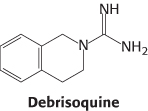
Question 26.23
Removal of odorants. Many odorant molecules are highly hydrophobic and concentrate within the olfactory epithelium. They would give a persistent signal independent of their concentration in the environment if they were not rapidly modified. Propose a mechanism for converting hydrophobic odorants into water-
Question 26.24
Development difficulties. Propecia (finasteride) is a synthetic steroid that functions as a competitive and specific inhibitor of 5α-reductase, the enzyme responsible for the synthesis of dihydrotestosterone from testosterone.
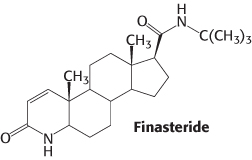
In addition to its use as a treatment for benign prostatic hypertrophy (Problem 21), finasteride is also widely used to retard the development of male pattern hair loss. Pregnant women are advised to avoid handling this drug. Why is it vitally important that pregnant women avoid contact with Propecia?
Question 26.25
Life-
Question 26.26
Personalized medicine. The cytochrome P450 system metabolizes many medicinally useful drugs. Although all human beings have the same number of P450 genes, individual polymorphisms exist that alter the specificity and efficiency of the proteins encoded by the genes. How could knowledge of individual polymorphisms be useful clinically?
Question 26.27
Honeybee crisis. In 2006, there was a sudden, unexplained die-
799
Question 26.28
Missing enzyme. Congenital adrenal hyperplasia is a life-
Question 26.29
Let the sun shine in. At a biochemical level, vitamin D functions like a steroid hormone (Chapter 31). Therefore, it is sometimes referred to as an honorary steroid. Why is vitamin D not an actual steroid?
Mechanism Problems
Question 26.30
An interfering phosphate. In the course of the overall reaction catalyzed by HMG-
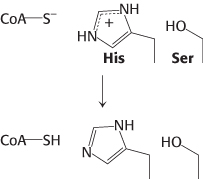
A nearby serine residue can be phosphorylated by AMP-
Question 26.31
Demethylation. Methyl amines are often demethylated by cytochrome P450 enzymes. Propose a mechanism for the formation of methylamine from dimethylamine catalyzed by cytochrome P450. What is the other product?
Chapter Integration Problems
Question 26.32
Similarities. Compare the role of CTP in phosphoglyceride synthesis with the role of UTP in glycogen synthesis.
Question 26.33
Hold on tight or you might be thrown to the cytoplasm. Many proteins are modified by the covalent attachment of a farnesyl (C15) or a geranylgeranyl (C20) unit to the carboxyl-
Question 26.34
Fork in the road. 3-
Question 26.35
Requires a club membership. How is methionine metabolism related to the synthesis of phosphatidylcholine?
Question 26.36
Drug resistance. Dichlorodiphenyltrichloroethane (DDT) is a potent insecticide rarely used today because of its effects on other forms of life. In insects, DDT disrupts sodium channel function, leading to eventual death. Mosquitos have developed resistance to DDT and other insecticides that function in a similar fashion. Suggest two means by which DDT resistance might develop.
Question 26.37
ATP requirements. Explain how cholesterol synthesis depends on the activity of ATP-
Data Interpretation and Chapter Integration Problem
Question 26.38
Cholesterol feeding. Mice were divided into four groups, two of which were fed a normal diet and two of which were fed a cholesterol-
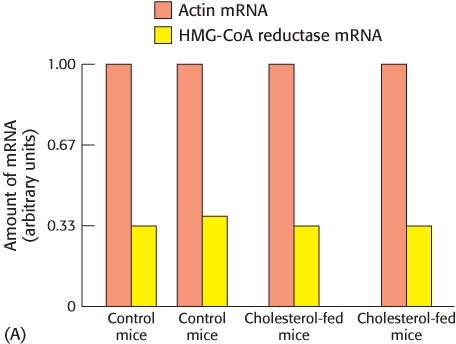
What is the effect of cholesterol feeding on the amount of HMG-
CoA reductase mRNA? What is the purpose of also isolating the mRNA for the protein actin, which is not under the control of the sterol regulatory element?
HMG-
CoA reductase protein was isolated by precipitation with a monoclonal antibody to HMG- CoA reductase. The amount of HMG- CoA protein in each group is shown in graph B. 
800
What is the effect of the cholesterol diet on the amount of HMG-
CoA reductase protein? Why is this result surprising in light of the results in graph A?
Suggest possible explanations for the results in graph B.
Question 26.39
Gaucher disease. Gaucher disease, the most common lysosomal storage disease in humans, is caused by mutations in the gene encoding glucocerebrosidase (GCase), the lysosomal enzyme that degrades glucocerebrosides. The disease has a variety of symptoms depending on the severity of the disease and the person affected. Identical twins can display very different levels of severity. Symptoms include bone pain, enlarged liver, excessive fatigue, and mental retardation.
In order to better understand the disease, researchers undertook a series of experiments to characterize the nature of the defect in the enzyme. Cells were obtained from a person without the disease (control) as well as from a patient with the disease (GD). The cells were grown in culture, the enzyme was isolated, and enzyme activity of 10 μg of each sample was measured (Figure A).
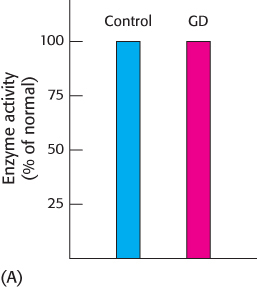
What do the results tell about the catalytic activity of the enzyme from the GD cells? Why were these results surprising to the researchers?
Again, cells were grown in culture and cell extracts were made from the control and GD samples. Care was taken to insure that the same number of cells were used in both extractions. A western blot with antibodies to GCase was performed on the cell extracts, with the results shown in Figure B.
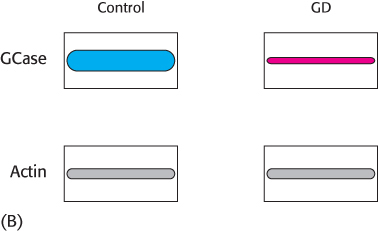 [Data from J. Lu, Proc. Natl. Acad. Sci. U. S. A. 107:21665–
[Data from J. Lu, Proc. Natl. Acad. Sci. U. S. A. 107:21665–21670, 2012.] Provide two possible explanations for the result shown in Figure B. Why was it crucial to insure that the extract was made from the same number of cells? What was the purpose of including the western blot of actin?
The researchers then measured the amount of mRNA for the enzyme in both the control and GD cells. The amount of mRNA was identical in the two samples. With this information, reinterpret the results shown in Figure B.
Next, cells from the control and GD individuals were grown in the presence and absence of a potent proteasome inhibitor. The amount of GCase was determined using western blots. The results are shown in Figure C.
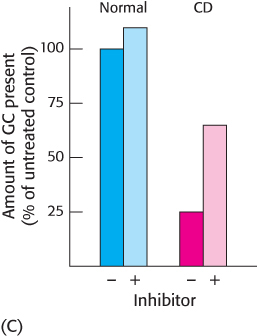 [Data from J. Lu, Proc. Natl. Acad. Sci. U. S. A. 107:21665–
[Data from J. Lu, Proc. Natl. Acad. Sci. U. S. A. 107:21665–21670, 2012.] Suggest the nature of the defect in the GD enzyme. What is the significance of the increase in activity of the enzyme from the normal cell observed in the presence of the inhibitor?